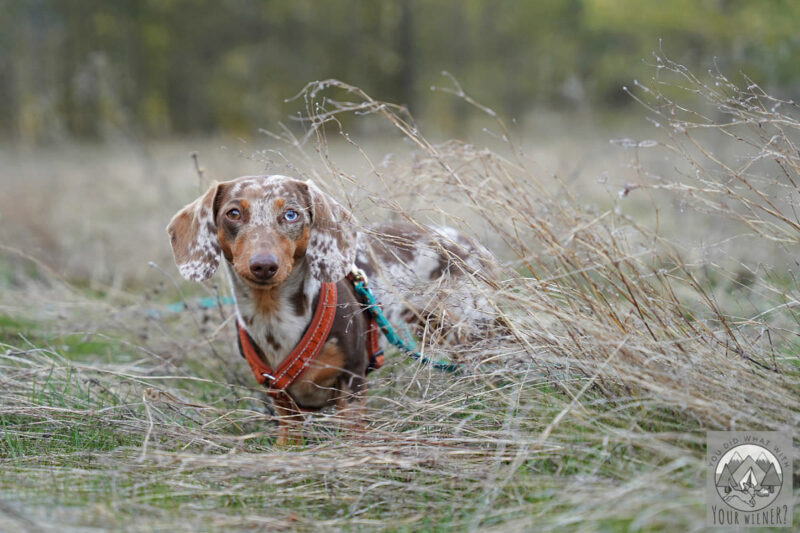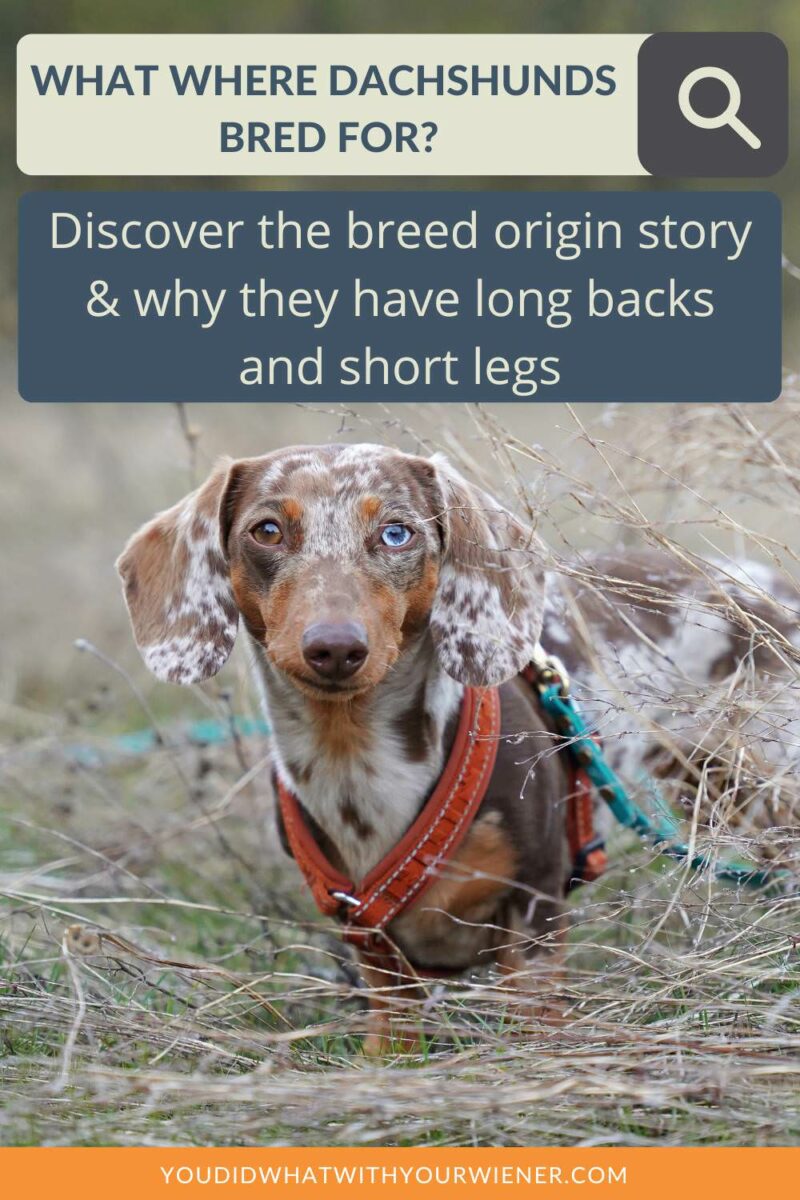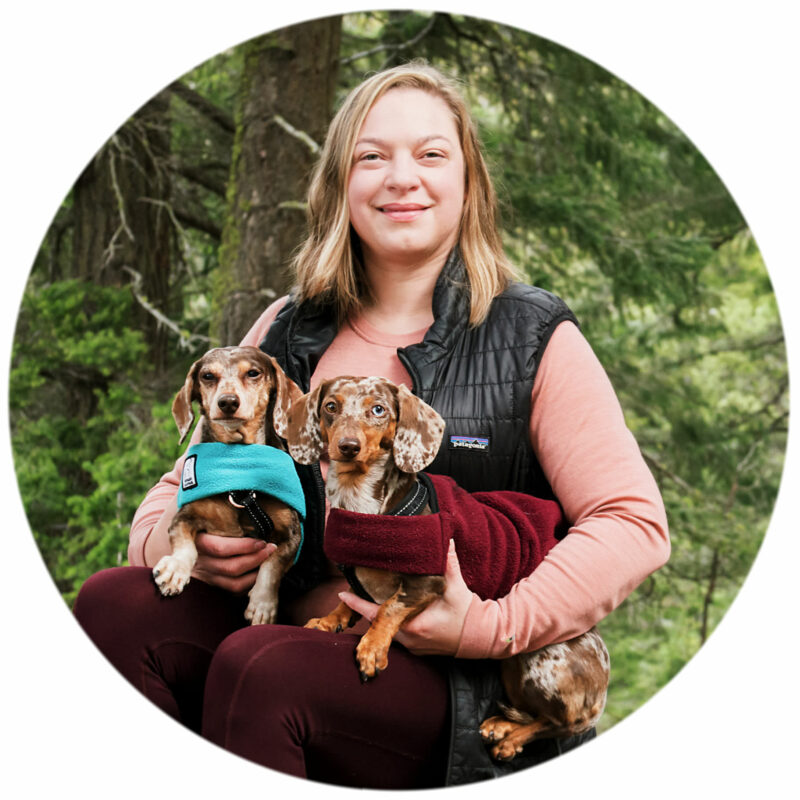What Were Dachshunds Bred For?
The Dachshund breed was originally bred for hunting.
A lot of the Dachshunds breed traits and characteristics are because of their original purpose.
Although Dachshunds are not typically used for hunting anymore, at least not in the United States, people around the world have fallen in love with this quirky breed with a unique look.

Read on for a little more information about how the Dachshund came to be and what they were originally used for.
The Dachshund Breed History
The Dachshund breed, also known as “sausage dog”, “wiener dog”, or other nicknames, originated in Germany in the early 16th century.
They were bred to hunt badgers and other burrowing animals by entering their underground dens and tunnels.
Dachshunds were created by crossing a variety of different breeds, including the Basset Hound, the Bloodhound, and the Pinscher.
Dachshunds were first officially recognized as a breed by the German Kennel Club in 1879.
Although they were initially used for hunting, over time they became popular as companion pets as well.
Dachshunds were first imported to the United States in the late 19th century, and quickly gained popularity.
They were recognized by the American Kennel Club in 1885, and have been one of the most popular breeds in the United States ever since.
Dachshunds come in three different coat types: smooth, wirehaired, and longhaired.
They also come in two size varieties: standard and miniature (read about the difference HERE)
Dachshunds have a reputation for being lively and playful, as well as being very affectionate with their owners.
They are also known for being independent and sometimes stubborn.
They are also known to be protective of their owners and barking a lot.
Why Are Dachshunds Shaped Funny?
Their unique elongated body shape, with a long back and short legs, was specifically developed to allow them to navigate through narrow burrows and dens.
Their characteristic looks are due to chondrodyspasia, also known as canine dwarfism, which is a recessive genetic defect found in pure bred dogs.
This disorder causes the abnormal growth of cartilage and results in the disproportionate growth of a dogs limbs which causes short legs.
Note: This means a Dachshund is not a dog with regular legs and a long back but instead is a dog with a regular length back and disproportionally short legs.
The long back and short legs allow them to easily enter and maneuver through the small underground tunnels, while the short legs also help them to maintain balance while doing so.
Additionally, their long back also makde them a perfect hunting companion for flushing out small game from narrow holes and dens.
The name for the hotdog was actually inspired by this long and low “sausage dog” breed.
First called “Dachshund Sausage,” the term was shortened to hotdog and it’s stuck ever since.
What Did Dachshund Originally Look Like?
The original Dachshund was only one size and closer in weight to what we think of as standard Dachshunds today (typically 16-32 lbs).
They had a short, smooth coat that was usually a variety of solid colors such as red, black, and tan.
As the breed evolved, different coat types and sizes were developed.
The wirehaired Dachshund variety was developed to have a wiry coat that could protect them from the burrows and dens they hunted in.
The longhaired Dachshund variety was developed to have a longer, silky coat.
Both the wirehaired and longhaired varieties were developed in the 19th century.
It’s thought that the Dachshund was crossed with a wire terrier to get the wirehair Dachshund.
It’s thought that the Dachshund was crossed with a long-hair spaniel to get the long hair.
The smaller, miniature Dachshund variety was also developed in the 19th century by breeding the standard Dachshund with smaller dog breeds.
Are Dachshunds Still Used For Hunting?
Dachshunds are not widely used for hunting today as they were traditionally used.
Today, they are primarily kept as companion animals.
However, some people still use them for hunting small game, such as rabbits, and they can also be trained to hunt other animals like raccoons or badgers.
Some Dachshunds have also been taught to track a hunter’s wounded game.
While Dachshunds were not originally bred for tracking specific scents over long distances, like Bloodhounds or Beagles, but, if trained properly, their grit, determination, ability to solve problems, and desire for a reward, make them pretty good at it.
The most common type of Dachshund I see used for hunting and tracking is the standard wirehair.
They are also used in some specific hunting competitions and events, such as Earthdog Trials, where they compete in simulated hunting tests that evaluate their instincts and abilities to track and locate prey in underground tunnels.
Behavior Stemming From the Hunting Instinct
Now that you know what Dachshunds were bred for, you may start to look at some of your dog’s behaviors in a new light.
Many traits and characteristics that made Dachshunds great hunters, can result in undesired behaviors, or behavior issues, when living as a companion animal in your home.
Once example is the Dachshunds big bark, which can be disruptive and excessive in some cases.
But once you embrace their nature, you will be less frustrated and perhaps more motivated to work on training to reduce how much your dog barks.
Your Dachshund is not being a jerk, they are literally doing the only thing they know how to (before training that teaches them what to do instead).
Dachshunds also have a reputation for being difficult to train.
However, what underlies that stereotype is that Dachshunds are very smart, clever, problem solvers. And they are relentless in their pursuits.
This means that they aren’t necessarily trying to be disobedient – your dog is just trying to find the shortest way to get what they want (the treat you are holding).
Final Thoughts
Many people buy a dog based on looks.
A good portion of those also research breed traits and characteristics beforehand so they are sure a particular dog breed it suited to their lifestyle.
Understanding what the Dachshund was originally bred for is important because it can explain many of their traits, characteristics, and potential behavior issues.
For example, one major complaint about Dachshunds is that they bark a lot.
But if you understand that the Dachshund breed was created for hunting, which required a dog to alert the hunter to prey by barking, you will better understand why your Dachshund barks all the time.
When you know it’s natural instinct for them to do so, the barking may be easier to tolerate or even excepted.
Despite their nature though, it is possible to reduce the amount a Dachshund barks.


About the Author
Hi, I’m Jessica. I’ve been studying the Dachshund breed since 2007, owned 3 of my own, and shared in the lives of thousands of others through their owner’s stories. When I’m not sharing what I know on this blog, you can find me hiking, camping, and traveling with my adventurous wiener dogs.
